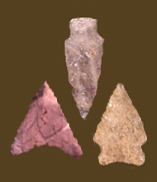
|
NORMANSKILL
Chronology The Normanskill has been variously placed in the Middle and Late Archaic periods, although radiocarbon dating supports the latter age. Kinsey (1972) reports radiocarbon dates of 1930 +/- 100 BC and 1350 +/- 200 BC (approximately 2450 and 1650 BC in calendar years) for the type in New York. Funk (1993) indicates that radiocarbon dates and stratigraphic position place the Normanskill between 1900 and 1600 BC (2350-1850 BC calendar) in the Upper Susquehanna Valley. Description Blade: The blade is narrow and triangular, with straight to slightly excurvate edges and a biconvex cross section. Asymmetry of the shoulders sometimes occurs, with one at an acute angle and the other at an obtuse angle. Haft Element: The stem has wide, deep, sometimes squarish side notches, and is slightly thinned by coarse flaking from the base. The base is expanded, and is generally straight, but some examples are slightly concave. Basal grinding occasionally occurs. Size: The length ranges from 37 to 70 mm, with the majority averaging 41 to 51 mm. The width ranges from 16 to 32 mm, and the thickness from 5 to 10 mm. Technique of manufacture: Percussion is used for the rough shaping of the point, and pressure flaking to produce the marginal retouching. Material: In the area surrounding Zekiah Swamp on the lower Potomac, Wanser (1982) found that 54% of 199 Normanskill and “Normanskill-like” points were quartzite, with 40% quartz, 5% rhyolite, and 1% argillite. Normanskills found in the middle Potomac River Valley are made of cherts, rhyolite, and quartzite (Hranicky 2002). Discussion Defined in Literature The Normanskill point was first defined by Ritchie in 1961, with revisions in 1971. It was named after the Normanskill, a tributary of the Hudson River in eastern New York. References |
![]()
Search by Shape:
(See Projectile Point Typology) |

|
Thank you for visiting our website. If you have any
questions, comments, Copyright © 2002 by |

|

 Defining Attributes
Defining Attributes